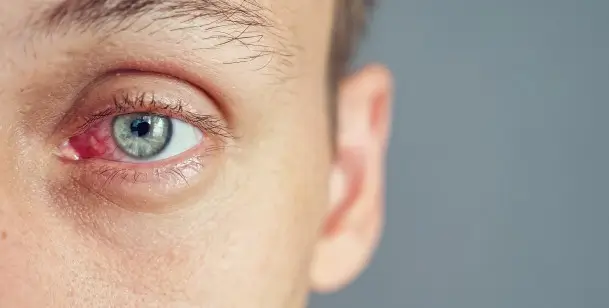The common eye condition known as pink eye, or conjunctivitis, is marked by redness, irritation, and discharge. Although infections, allergies, or irritants are usually the cause, other eye disorders might mirror its symptoms and give a false positive. This page examines illnesses that are frequently confused with pink eye, outlines how to tell them apart, and includes a thorough FAQ section to answer frequently asked questions.
Often Misdiagnosed Conditions as Pink Eye
1. Rheumatism
Similar to pink eye, blepharitis is an inflammation of the eyelids that can result in redness, itching, and a grainy feeling. Blepharitis mainly affects the margins of the eyelids instead of the conjunctiva, in contrast to conjunctivitis. It is frequently linked to ailments like bacterial infections, rosacea, and dandruff.
Identifying Characteristics:
scaly skin around the eyes
brittle eyelashes, particularly in the morning
greasy look of the eyelids
puffiness of the eyelids
2. Contact dermatitis
An immunological reaction to allergens including pollen, dust, or pet dander is known as allergic conjunctivitis. It does not involve infectious pathogens, despite having many of the same symptoms as infectious conjunctivitis, such as redness and irritation.
Identifying Characteristics:
Usually, both eyes are impacted.
accompanied by additional allergy symptoms such as nasal congestion and sneezing
No green or yellow discharge, usually a watery, transparent discharge
3. Syndrome of Dry Eyes
When the eyes do not produce enough tears or the tears evaporate too quickly, dry eye syndrome develops. It may result in burning and redness, confusing people with pink eye.
Identifying Characteristics:
Constant discomfort and dryness
Light Sensitivity
eyesight impairment that gets better when you blink
Dry, windy, or air-conditioned environments exacerbate symptoms.
4. Ocular irritation
An inflammation of the uvea, the central layer of the eye, is called uveitis. Significant redness, discomfort, and light sensitivity may result from it, and these symptoms could be misinterpreted for acute conjunctivitis.
Identifying Characteristics:
A sharp, deep ache in the eye
Diminished vision
Light sensitivity (photophobia)
The existence of floaters
5. Inflammation of the skin
An inflammation of the cornea known as keratitis can be brought on by wounds, infections, or prolonged use of contact lenses. It has similar symptoms as pink eye, such as redness and drainage, but if left untreated, it can result in more serious issues.
Identifying Characteristics:
ocular pain
having a sensation in the eyes
Diminished vision
apparent opacities or sores on the cornea during examination
Differentiating In-between Situations
For the right course of treatment, an accurate diagnosis of eye problems is essential. The following are important diagnostic actions:
Patient History: Knowing when symptoms start, how long they last, and any related conditions (such as allergies or contact lens wear) might help identify key indicators.
Physical Assessment: Slit-lamp microscopy eye exams provide a thorough look of the eye’s structures.
Laboratory testing: To pinpoint the precise source of inflammation, cultures or other testing may be required in some circumstances.
FAQs
What are the main reasons why people get pink eye?
Allergens, irritants, and bacterial or viral infections can all result in pink eye. High-contagious viral conjunctivitis frequently coexists with upper respiratory tract infections. Additionally easily transmissible, bacterial conjunctivitis is characterized by a thick, yellow-green discharge. The body’s immunological reaction to irritants like pollen or pet dander causes allergic conjunctivitis.
What is the difference between a bacterial and viral pink eye?
Watery discharge is the typical symptom of viral conjunctivitis, which affects both eyes. A thick, yellow-green discharge is frequently the first sign of bacterial conjunctivitis in one eye, and it might spread to the other. While redness and discomfort can be caused by either type, bacterial infections typically result in greater discharge.
Does pink eye go away on its own?
It’s true that viral and allergic conjunctivitis frequently go away on their own in one to two weeks. You might need to use antibiotic eye drops or ointment for bacterial conjunctivitis. If symptoms intensify or persist, it’s imperative to consult a healthcare professional.
What are some ways to stop pink eye from spreading?
Maintain proper hygiene to stop the spread of pink eye:
Hands should be often cleaned with soap and water.
Refrain from rubbing or touching your eyes.
Never share personal products like makeup, towels, or washcloths.
After using disposable contact lenses during an infection, clean your glasses.
Is it possible to treat pink eye at home?
Although they help reduce symptoms, home cures cannot treat the underlying cause. Warm compresses can be used to ease pain, while artificial tears can be used to ease irritation and dryness. Over-the-counter eye drops that reduce redness should not be used as they can exacerbate symptoms over time.
If I have pink eye, when should I see a doctor?
Obtain medical assistance if
You feel excruciating pain, light sensitivity, or changes in your vision.
The symptoms get worse or last longer than a week.
You either already have eye issues or have a compromised immune system.
There’s a chemical exposure or something foreign in the eye.
Can pink eye cause long-term visual impairment?
The majority of pink eye episodes don’t result in irreversible visual loss. However, if serious infections are not treated right away, problems may occur. If left untreated, conditions such as keratitis or uveitis that are mistaken for pink eye can cause visual loss.
Are some groups more prone to pink eye than others?
People of all ages can get pink eye. But because of the close quarters at daycare centers and schools, it is more common in kids. A increased risk is also associated with allergies and regular exposure to irritants.
Is pink eye a result of wearing contact lenses?
It is true that poor contact lens care can cause fungal or bacterial infections that cause conjunctivitis. Always take care of your lenses according to the instructions, don’t wear them overnight, and replace them when your eye doctor says.
What are the long-term consequences for people who get pink eye a lot?
Chronic conjunctivitis and other eye disorders might result from pink eye episodes that occur frequently. Reducing the frequency of recurrence can be achieved by controlling underlying allergies, keeping your eyes clean, and avoiding recognized irritants. Frequent eye exams aid in the monitoring and treatment of recurring problems.
In summary
Misdiagnosis of pink eye can cause complications and postpone necessary treatment. It is important to recognize the signs and symptoms of other eye illnesses, such as keratitis, blepharitis, allergic conjunctivitis, dry eye syndrome, and uveitis. Seek a professional assessment if you have discharge, redness, or irritation in your eyes to ensure proper diagnosis and treatment.
You can preserve the health of your eyes and safeguard your eyesight by being knowledgeable and taking proper care of them. Seek the advice and treatment of a qualified eye care specialist if you have any concerns or symptoms.



